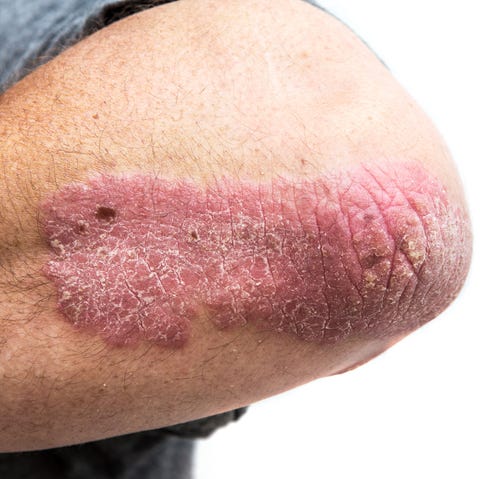
Catherine Falls CommercialGetty Images
No one has to tell you (or your dry, cracked heels, knuckles, and cheeks) that winter can do a number on your skin. But there’s a difference between chapped skin needing extra moisturizer and a more serious condition like eczema or psoriasis. With both, your skin develops a rash, becomes discolored, and gets itchy. Apart from that, it may be hard to tell them apart.
A few clues: Psoriasis usually develops in adults ages 20 to 30 years old. (A study published in 2017 in the American Journal of Clinical Dermatology suggests that men have a higher incidence of severe psoriasis than women.) Atopic dermatitis, the most common type of eczema, on the other hand, typically begins in childhood.
Still not sure what you’re dealing with? Keep reading for more clues to see if you’re suffering from more than just dry skin.
1. You have dry, cracked skin that can’t be quenched.
If your parched skin improves with a heavy dose of moisturizer, it’s likely just winter-weary dry. But if it’s rough, cracked and covered in what looks like thick, well-defined, red, scaly patches, this may be a sign that you have psoriasis. “In its very early phases, psoriasis can often look like dry skin or itchy skin that doesn’t have any visible skin signs,” says Seemal Desai, MD, a dermatologist and clinical assistant professor at The University of Texas Southwestern Medical Center in Dallas, TX. “Over time, this can develop into more and thicker scaly areas.” Another clue? If you pull off the scale, you have pinpoint bleeding, which often happens with psoriasis.
2. Your skin is intensely itchy.
Even mildly dry skin can be scratchy. But if it continues to be that way after multiple rounds of lotion, it may be an early sign of eczema or psoriasis. With both conditions, the skin may burn or feel extremely itchy, according to the National Psoriasis Foundation. That’s especially true among people with eczema.
Not sure which one it might be? Make an appointment with your derm. “It’s always important to seek the care of a board-certified dermatologist to evaluate any itchy, dry, scaly, and new skin eruptions that show up or are not improving,” says Dr. Desai.
3. Breakouts are happening on your knees and elbows.
Location is a big tip-off that you may have more than just dry skin. Although psoriasis can show up anywhere—including the belly button, scalp, lower back, and other areas—they commonly appear on the back of elbows and front of knees, explains Dr. Desai. Eczema, on the other hand, involves the opposite locations, showing up in the crook of elbows and behind the knees.
4. Your nails look strange.
We aren’t talking run-of-the-mill nail fungus or the black-and-blue parting gift of a stubbed toe or marathon memento. Abnormal nail growth, discoloration, and small cracks and depressions in the nail known as “pitting”—are signs of psoriasis. In severe cases, your nails might crumble, loosen, and even fall off.
Research, including a study published in Reumatologia, found that people whose psoriasis manifests in their nails have a greater risk of more severe health consequences. If you’re losing nails regularly, Dr. Desai recommends speaking with your doctor or medical professional.
5. Your scalp is painfully flaky.
What may initially be mistaken for dandruff may actually be localized psoriasis, says Dr. Desai. How can you tell the difference? Your scalp is sore or feels as though it’s burning. And unlike dandruff, scalp psoriasis causes a silvery sheen texture, and the affected areas are often dry to the point of cracking and bleeding. Among people with psoriasis, 45 to 56 percent have scalp psoriasis, according to a study published in Clinical and Experimental Dermatology.
If you have psoriasis, it can impact your life in many ways, but there’s no need to let it get in the way of your living a full life. Talk to your dermatologist about how you can live with the condition, not in spite of it.
This content is created and maintained by a third party, and imported onto this page to help users provide their email addresses. You may be able to find more information about this and similar content at piano.io




Comments are closed.